Related Research Articles

The Articles of Confederation and Perpetual Union was an agreement among the 13 states of the United States, formerly the Thirteen Colonies, that served as the nation's first frame of government. It was debated by the Second Continental Congress at Independence Hall in Philadelphia between July 1776 and November 1777, and finalized by the Congress on November 15, 1777. It came into force on March 1, 1781, after being ratified by all 13 colonial states. A guiding principle of the Articles was the establishment and preservation of the independence and sovereignty of the states. The Articles consciously established a weak confederal government, affording it only those powers the former colonies had recognized as belonging to king and parliament. The document provided clearly written rules for how the states' league of friendship, known as the Perpetual Union, would be organized.

The 1788–89 United States presidential election was the first quadrennial presidential election. It was held from Monday, December 15, 1788, to Wednesday, January 7, 1789, under the new Constitution ratified that same year. George Washington was unanimously elected for the first of his two terms as president and John Adams became the first vice president. This was the only U.S. presidential election that spanned two calendar years without a contingent election and the first national presidential election in American history.

The Federalist Papers is a collection of 85 articles and essays written by Alexander Hamilton, James Madison, and John Jay under the collective pseudonym "Publius" to promote the ratification of the Constitution of the United States. The collection was commonly known as The Federalist until the name The Federalist Papers emerged in the twentieth century.

Anti-Federalism was a late-18th-century political movement that opposed the creation of a stronger U.S. federal government and which later opposed the ratification of the 1787 Constitution. The previous constitution, called the Articles of Confederation and Perpetual Union, gave state governments more authority. Led by Patrick Henry of Virginia, Anti-Federalists worried, among other things, that the position of president, then a novelty, might evolve into a monarchy. Though the Constitution was ratified and supplanted the Articles of Confederation, Anti-Federalist influence helped lead to the passage of the Bill of Rights.

Article Seven of the United States Constitution sets the number of state ratifications necessary for the Constitution to take effect and prescribes the method through which the states may ratify it. Under the terms of Article VII, constitutional ratification conventions were held in each of the thirteen states, with the ratification of nine states required for the Constitution to take effect. Delaware was the first state to ratify the Constitution, doing so on December 7, 1787. On June 21, 1788, New Hampshire became the ninth state to ratify the Constitution, ensuring that the Constitution would take effect. Rhode Island was the last state to ratify the Constitution under Article VII, doing so on May 29, 1790.

The United States Constitution has served as the supreme law of the United States since taking effect in 1789. The document was written at the 1787 Philadelphia Convention and was ratified through a series of state conventions held in 1787 and 1788. Since 1789, the Constitution has been amended twenty-seven times; particularly important amendments include the ten amendments of the United States Bill of Rights and the three Reconstruction Amendments.
Anti-Federalist Papers is the collective name given to the works written by the Founding Fathers who were opposed to, or concerned with, the merits of the United States Constitution of 1787. Starting on 25 September 1787 and running through the early 1790s, these Anti-Federalists published a series of essays arguing against the ratification of the new Constitution. They argued against the implementation of a stronger federal government without protections on certain rights. The Anti-Federalist papers failed to halt the ratification of the Constitution but they succeeded in influencing the first assembly of the United States Congress to draft the Bill of Rights. These works were authored primarily by anonymous contributors using pseudonyms such as "Brutus" and the "Federal Farmer." Unlike the Federalists, the Anti-Federalists created their works as part of an unorganized group.

Federalist No. 14 is an essay by James Madison titled "Objections to the Proposed Constitution From Extent of Territory Answered". This essay is the fourteenth of The Federalist Papers. It was first published in The New York Packet on November 30, 1787 under the pseudonym Publius, the name under which all The Federalist papers were published. It addresses a major objection of the Anti-Federalists to the proposed United States Constitution: that the sheer size of the United States would make it impossible to govern justly as a single country. Madison touched on this issue in Federalist No. 10 and returns to it in this essay.

Federalist No. 66 is an essay by Alexander Hamilton, the sixty-sixth of The Federalist Papers. It was published on March 8, 1788, under the pseudonym Publius, the name under which all The Federalist papers were published. The title is "Objections to the Power of the Senate To Set as a Court for Impeachments Further Considered".

Federalist No. 85 is an essay by Alexander Hamilton, the eighty-fifth and last of The Federalist Papers. It was published on August 13 and 16, 1788, under the pseudonym Publius, the name under which all The Federalist papers were published. The title is "Concluding Remarks".

The Virginia Ratifying Convention was a convention of 168 delegates from Virginia who met in 1788 to ratify or reject the United States Constitution, which had been drafted at the Philadelphia Convention the previous year.
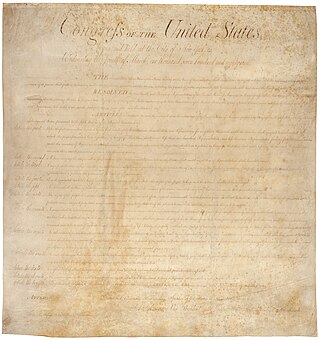
The United States Bill of Rights comprises the first ten amendments to the United States Constitution. Proposed following the often bitter 1787–88 debate over the ratification of the Constitution and written to address the objections raised by Anti-Federalists, the Bill of Rights amendments add to the Constitution specific guarantees of personal freedoms and rights, clear limitations on the government's power in judicial and other proceedings, and explicit declarations that all powers not specifically granted to the federal government by the Constitution are reserved to the states or the people. The concepts codified in these amendments are built upon those in earlier documents, especially the Virginia Declaration of Rights (1776), as well as the Northwest Ordinance (1787), the English Bill of Rights (1689), and Magna Carta (1215).
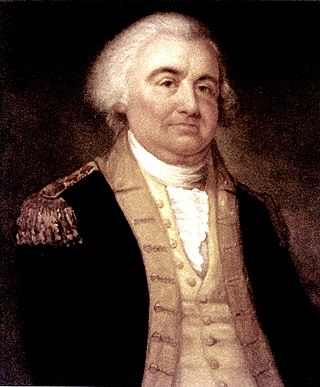
John Lamb (1735–1800) was an American soldier, politician, and Anti-Federalist organizer. During the American Revolutionary War he led the 2nd Continental Artillery Regiment.

The drafting of the Constitution of the United States began on May 25, 1787, when the Constitutional Convention met for the first time with a quorum at the Pennsylvania State House in Philadelphia, Pennsylvania to revise the Articles of Confederation. It ended on September 17, 1787, the day the Frame of Government drafted by the convention's delegates to replace the Articles was adopted and signed. The ratification process for the Constitution began that day, and ended when the final state, Rhode Island, ratified it on May 29, 1790.
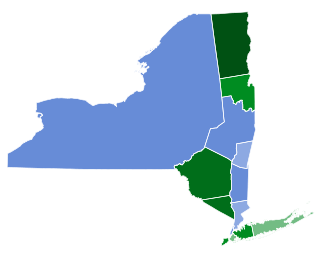
The 1789 New York gubernatorial election was held in April 1789 to elect the Governor of New York for a term beginning in July 1789. Incumbent Governor George Clinton was narrowly re-elected to a fifth consecutive term in office over Robert Yates.

The 1789 United States House of Representatives elections in New York were held on March 3 and 4, 1789, to elect 6 U.S. Representatives to represent the State of New York in the 1st United States Congress.

The 12th New York State Legislature, consisting of the New York State Senate and the New York State Assembly, met from December 11, 1788, to March 3, 1789, during the twelfth year of George Clinton's governorship, in Albany.

The 13th New York State Legislature, consisting of the New York State Senate and the New York State Assembly, met from July 6, 1789, to April 6, 1790, during the thirteenth year of George Clinton's governorship, first in Albany, then in New York City.
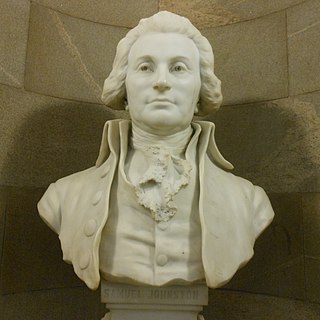
The Hillsborough Convention, was the first of two North Carolina conventions to ratify the United States Constitution. Delegates represented 7 boroughs and 59 counties, including six western counties that became part of Tennessee when it was created in 1796. They met in Hillsborough, North Carolina from July 21 to August 4, 1788 to deliberate and determine whether to ratify the Constitution recommended to the states by the General Convention that had been held in Philadelphia the previous summer. The delegates had won their seats through special elections held in March 1788, as mandated by the North Carolina General Assembly. Governor Samuel Johnston presided over the Convention. The Hillsborough Convention was dominated by anti-Federalists, and North Carolina did not ratify the Constitution until the Fayetteville Convention, which met a year later.
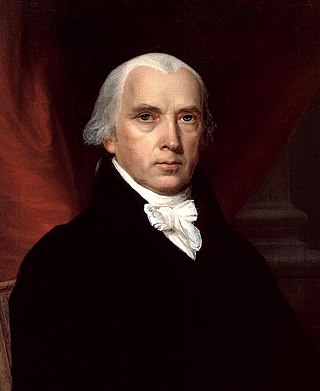
James Madison was an American statesman, diplomat, and Founding Father who served as the 4th president of the United States from 1809 to 1817. He is hailed as the "Father of the Constitution" for his pivotal role in drafting and promoting the Constitution of the United States and the Bill of Rights. Disillusioned by the weak national government established by the Articles of Confederation, he helped organize the Constitutional Convention, which produced a new constitution. Madison's Virginia Plan served as the basis for the Constitutional Convention's deliberations, and he was one of the most influential individuals at the convention. He became one of the leaders in the movement to ratify the Constitution, and he joined with Alexander Hamilton and John Jay in writing The Federalist Papers, a series of pro-ratification essays that was one of the most influential works of political science in American history.